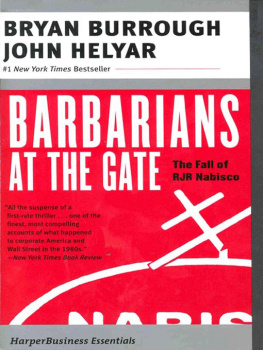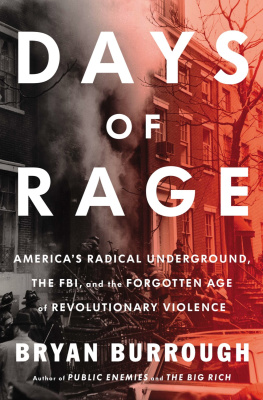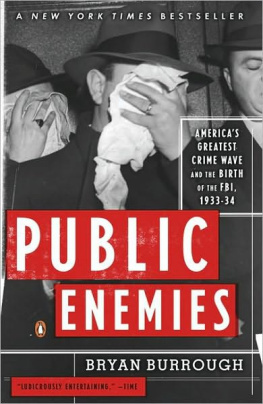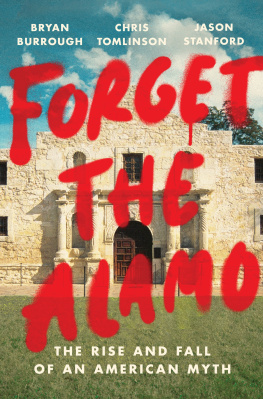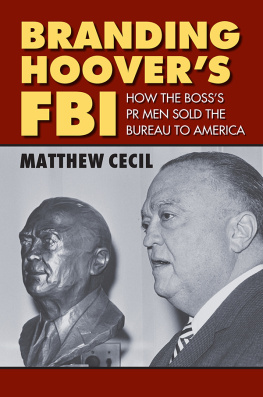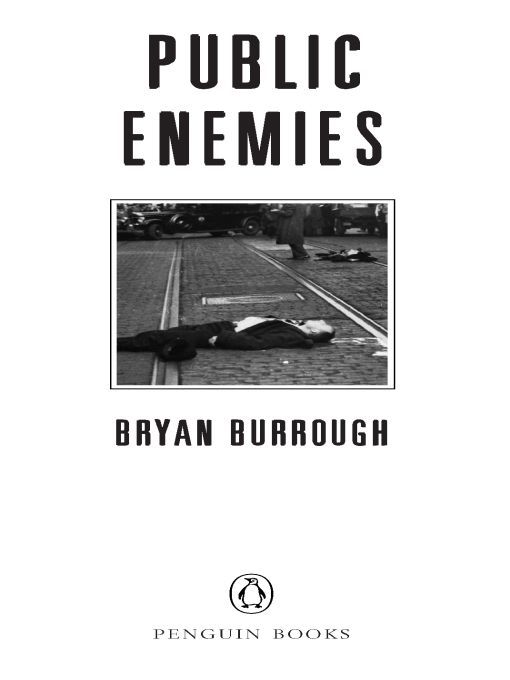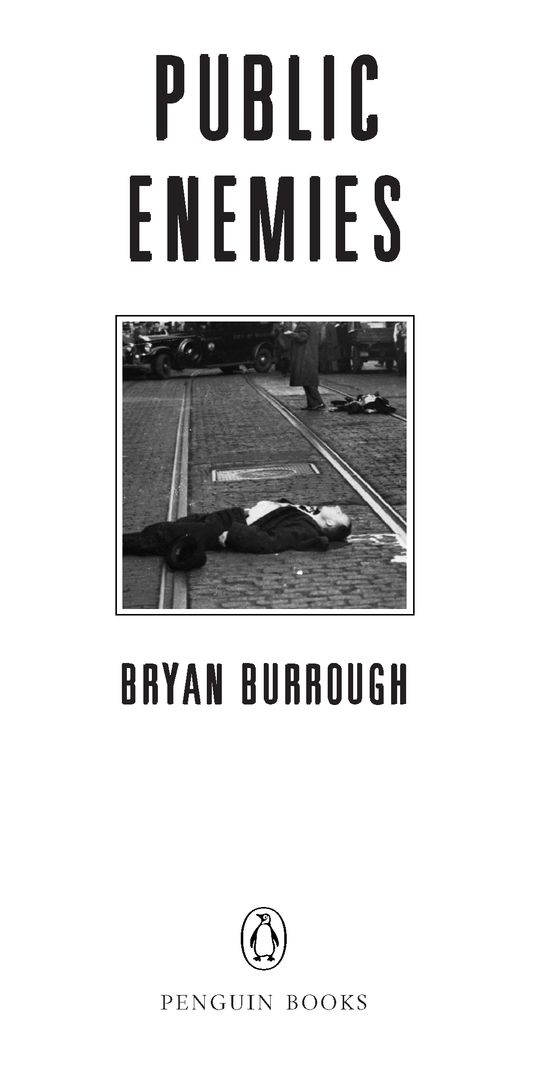Table of Contents
Praise for Public Enemies
Massively researched, ludicrously entertaining.
Time
[A] colorful new history of the early days of the Federal Bureau of Investigation.... [Burrough] has written a book that brims with vivid portraiture... Excellent true crime.
The New York Times Book Review
Public Enemies [is] Bryan Burroughs spellbinding new account of Americas first War on Crime... a model of narrative journalism and an often gripping read.
BusinessWeek
In the telling Mr. Burrough displays a genius for historical reconstruction and an attention to detail so vivid that the reader can almost smell Bonnie and Clyde, neither of whom showed much inclination to bathe during their months sleeping in cars or open fields when they were on the run.
The New York Times
Burroughs narrative is fast-paced, his prose captivating. Drawing upon several hundred thousand FBI documents, Burrough has conducted important new research. He re-creates in vivid detail the criminals whereabouts, characteristics, and ignominious rise to Depression-era fame.... By shining a spotlight on the FBIs birth... Burrough has altered our view of the early 1930s.
Chicago Tribune
It is superbreadable, thorough and critical.
The Denver Post
Fascinating... A rich and colorful cast of characters parades through the pages.... It is a wild and amazing story, and Burrough tells it with great gusto. Truth is often not only stranger than fiction but also a lot more interesting. Burroughs research is careful and extraordinarily thorough.... Public Enemies is a significant book, and a very readable one. It is easy to toss around terms like definitive, but this book deserves it. It is hard to imagine a more careful, complete and entrancing book on this subject, and on this era. Readers will not be disappointed.
The Washington Post
[An] excellent new history [of] this countrys greatest crime wave... [Burrough] brings a historians touch to the material, exploding myths on every page.... Public Enemies is knockout nonfiction entertainment as well as serious history.
The New York Sun
It is quite superb... with masses of new information.
Chicago Sun-Times
[An] engaging narrative... Burrough[s] book will make excellent reading for fans of American history and true crime.
San Francisco Chronicle
Gripping... [a] great tale.
New York Post
Bryan Burrough... has written a gripping history of just two years... when some of the more notorious criminals in American history harvested banks from Texas to Minnesota.... Mr. Burrough delineates this era with as much punchand much more insightthan any Warner Brothers gang-buster flick.
The Dallas Morning News
Gripping... Burrough expertly juggles six criminal gangs at one time, show[ing] the FBIs dramatic restructuring and captures the dark criminal days of the Depression.
The Star-Ledger (Newark)
[A] ceaselessly exciting book.
The Baltimore Sun
Bryan Burrough brings [these characters] roaring to life, like a getaway car speeding away after a bank robbery in his new book Public Enemies. Never before has the American past been given such an up-to-date polishing as Burrough gives a day-by-day account of a two-year period in which some outrageous and colorful desperadoes frightened and thrilled the public.
News-Times (Forest Grove, Oregon)
Public Enemies is a fascinating retelling of the FBIs famous War on Crime, weaving the stories of these outlaw gangs with the inner workings of the FBI, the men who were determined to stop them. Thanks to thousands of pages of recently declassified government files, it is exhaustively researched but as entertaining as any page-turning crime novel.... Must surely rank among the definitive works on the era and its crimes.
Daily Southtown (Chicago)
A 10-strike for the true crime fan.
Booklist
A rollicking, rat-a-tat ride... Iconoclastic and fascinating. A genuine treat for true-crime buffs.
Kirkus Reviews (starred review)
The definitive account of the 1930s crime wave that brought notorious criminals like John Dillinger and Bonnie and Clyde to Americas front pages.... [Burrough] successfully translates years of dogged research... into a graceful narrative.... This book compellingly brings back to life people and times distorted in popular imagination by hagiographic bureau memoirs and Hollywood.
Publishers Weekly (starred review)
PENGUIN BOOKS
PUBLIC ENEMIES
Bryan Burrough is a special correspondent at Vanity Fair and the author of numerous bestselling books, including Barbarians at the Gate: The Fall of RJR Nabisco (with John Helyar), Public Enemies: Americas Greatest Crime Wave and the Birth of the FBI, 1933-34, and The Big Rich: The Rise and Fall of the Greatest Texas Oil Fortunes. A former reporter for The Wall Street Journal, he is a three-time winner of the Gerald Loeb Award for Excellence in Financial Journalism. He lives in Summit, New Jersey, with his wife Marla and their two sons.
AMERICAS
GREATEST
CRIME WAVE
and the
BIRTHof
theFBI ,
1933 - 34
For Marla, Griffin, and Dane
The Unit
AUTHORS NOTE
Never before have I enjoyed researching and writing anything as much as I did the book you hold in your hands. If you derive half the pleasure from reading it as I did from creating it, I will be thrilled.
This is a book I always suspected I would attempt someday. The first stories I can remember hearing as a boy, the stories that made me want to become a writer, were tales my grandfather told of Bonnie and Clyde. As a young deputy in northwest Arkansas, John Vernon Burrough manned roadblocks set up to apprehend the couple. In his later years he was mayor of Alma, Arkansas, a town where Clyde Barrow was blamed for the murder of one of his predecessors. My grandfathers stories sounded like tales out of the Wild West; I could hardly grasp the fact that these events had occurred barely forty years earlier. I grew up in the 1970s, and the formative events of my youth were the Vietnam War, Watergate, and the Iranian hostage crisis. I couldnt believe America had changed that much in a single lifetime.
Later, I learned that Clyde Barrow had murdered the great-uncle of one of my boyhood friends in my hometown of Temple, Texas, and my interest grew. Stricken with insomnia late one night in 1997, I found myself watching a cable-television documentary on Ma Barker. I wondered whether the Barker Gang had been in operation before or after Bonnie and Clyde. I walked upstairs to my office and hopped on the Internet, ran a search, and was surprised to find that both gangs had been at large in the years 1933 and 1934. My curiosity aroused, I checked John Dillinger: 1933 and 1934. Pretty Boy Floyd, Baby Face Nelson, Machine Gun Kelly: all 1933 or 1934. This was my introduction to the War on Crime.
I picked up John Tolands 1963 book, Dillinger Days,


